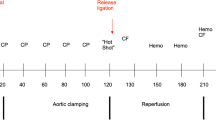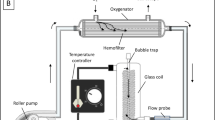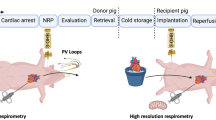Abstract
We propose modified warm blood antegrade-retrograde reperfusion (WBARR) of arrested hearts as a metabolic model with which to study substrate exchange and energy metabolism during the recovery phase after 90 min of ischaemia in man. Eleven anaesthetized patients undergoing aorto-coronary bypass were studied during WBARR. The protocol was designed as follows: period 1, a warm blood reperfusion with potassium (3 min); period 2, a warm blood reperfusion without potassium (2 min). The perfusion flow rate averaged 250±2 ml/min at the beginning of period 1 and 218±19 ml/min at the beginning and at the end of period 2; the perfusion was performed antegradely and retrogradely in the arrested hearts. Samples were simultaneously taken from the coronary venous sinus (CVS) and from the aortic root needle (AR). At the beginning of WBARR lactate release was 85±44 μmol/min and at the end it had significantly decreased to 21±99 μmol/min (P<0.03). Simultaneously, non-esterified fatty acids (NEFA) and β-hydroxy-butyrate were initially released (71±61 and 22±66 μmol/min, respectively), while at the end of the WBARR there was an uptake of both NEFA (20±22 μmol/min; P<0.01) and β-hydroxy-butyrate (12±35 μmol/min; P=0.290). Alanine, glycerol and branched chain amino acid balance across the heart did not significantly change. In summary after 90 min of ischaemia the heart energy metabolism is mainly anaerobic and based on glucose consumption, with lactate, NEFA and amino acids, which are mainly released. After 5 min of WBARR (recovery from ischaemia), lactate release is significantly reduced and NEFA becomes the energy supply of the heart. In conclusion, (1) WBARR is a valuable method with which to study myocardial metabolism in anaesthetized humans and may be combined with the use of tracers; (2) the study of myocardial metabolism in arrested hearts eliminates the imprecisions arising from the non-continuous coronary blood flow; (3) NEFA become an important source of energy utilized by human hearts in the recovery phase from ischaemia.
Similar content being viewed by others
Author information
Authors and Affiliations
Additional information
Received: 11 July 1997 / Accepted in revised form: 30 April 1998
Rights and permissions
About this article
Cite this article
Perseghin, G., Corno, A., Santoro, F. et al. Myocardial metabolism studied during warm blood antero-retrograde reperfusion in ischaemic human hearts. Acta Diabetologica 35, 67–73 (1998). https://doi.org/10.1007/s005920050105
Issue Date:
DOI: https://doi.org/10.1007/s005920050105




